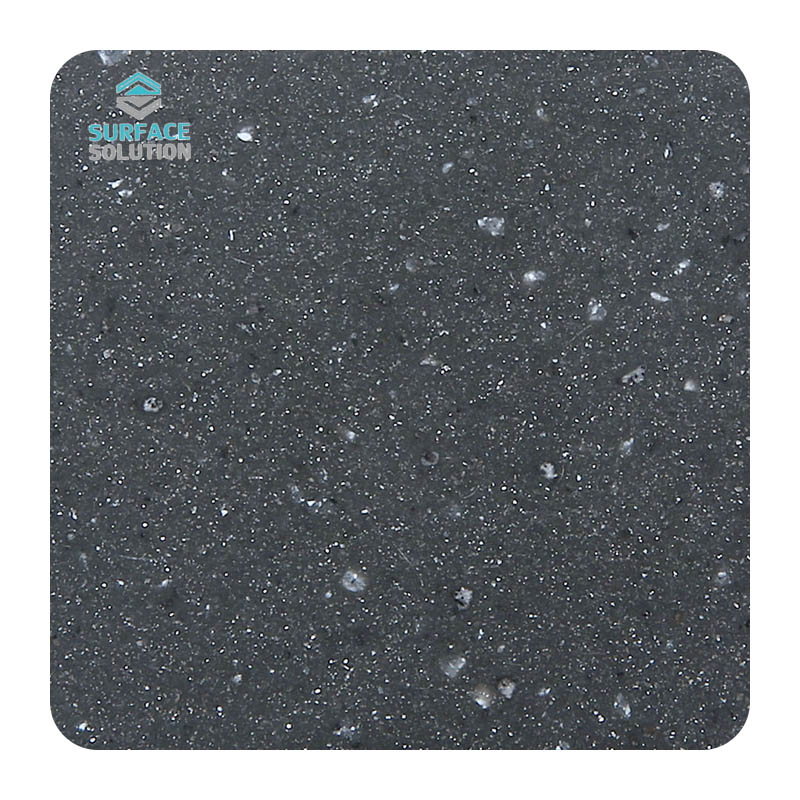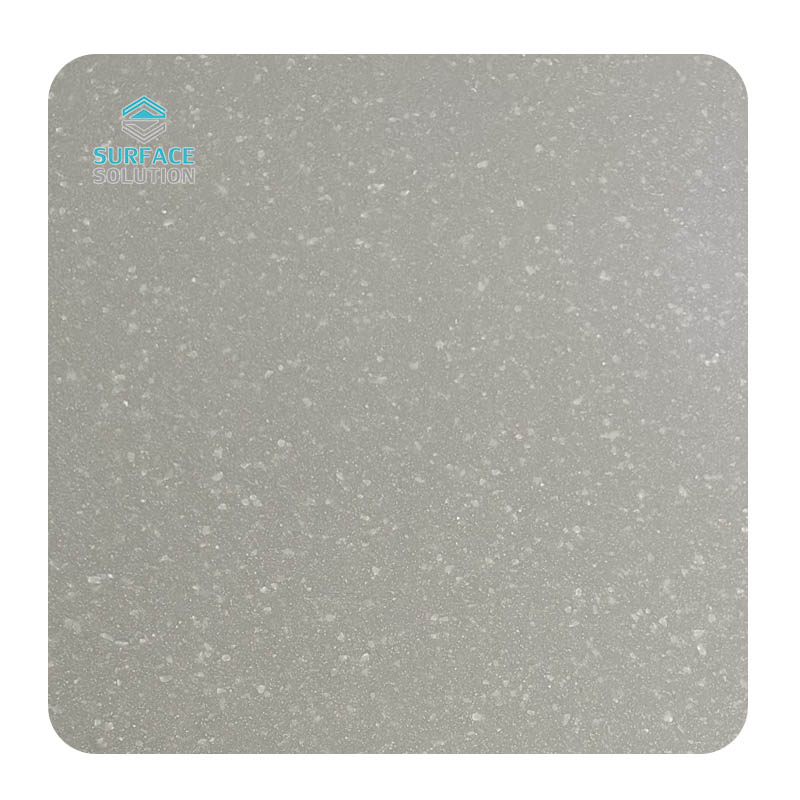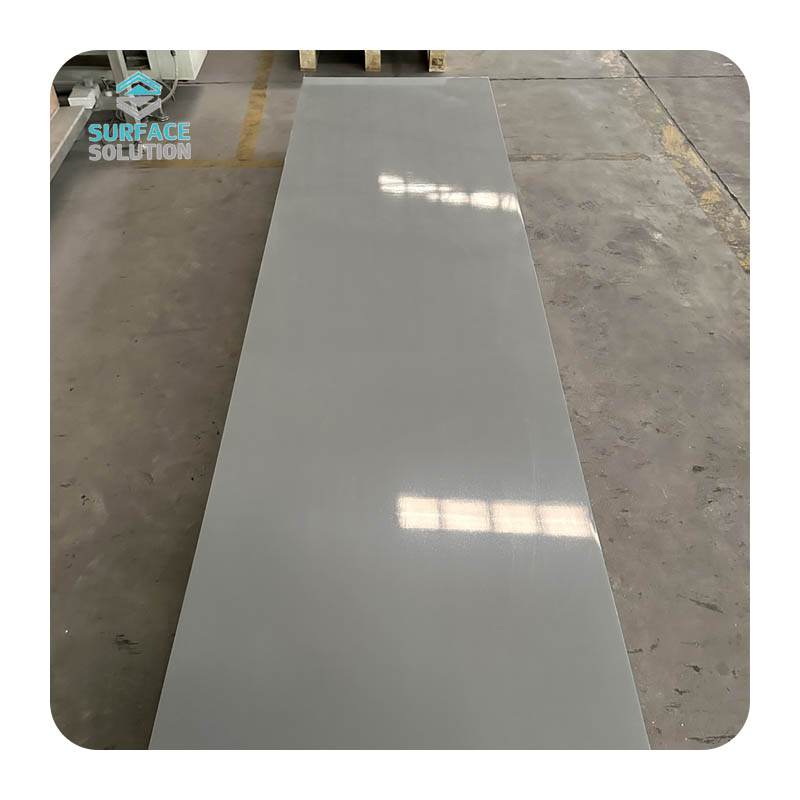

Acrylic Resin: The most common choice, acrylic resin (typically methyl methacrylate, or MMA) is prized for its flexibility and repairability. It allows countertops to be seamlessly joined (eliminating grout lines that trap dirt) and can be sanded or polished to fix scratches, stains, or minor chips. Acrylic-based solid surfaces also resist discoloration from sunlight or harsh cleaners, making them ideal for bright, high-traffic spaces.
Polyester Resin: Less expensive than acrylic, polyester resin is often blended with acrylic to reduce costs while retaining some durability. However, pure polyester solid surfaces are more prone to fading, cracking, or yellowing over time—especially when exposed to heat or chemicals like ammonia. They are still a viable option for low-use areas (e.g., guest bathroom vanities) but require more careful maintenance.

Aluminum Trihydrate (ATH): A white, powdery mineral derived from bauxite (the same ore used to make aluminum). ATH is non-toxic, heat-resistant, and flame-retardant—critical for kitchen surfaces that may come into contact with hot pots or pans. It also gives solid surfaces their signature "stone-like" texture without the porosity of natural stone (meaning liquids like wine or oil won’t seep in and stain).
Organic Pigments: Used for vibrant, saturated colors (e.g., deep greens or reds). They are often more fade-resistant than traditional dyes but can be pricier.
Inorganic Pigments: Ideal for earthy tones (beiges, browns) or subtle veining (to mimic natural stone). Minerals like iron oxide or titanium dioxide (which creates white) are durable and hold their color well over time.
High-quality solid surfaces have pigments evenly distributed throughout the material (called "through-color"), so if the surface is sanded, the color remains consistent—unlike laminate, where the color is only a top layer.

Curing Agents: Trigger the resin to harden during production, ensuring the countertop retains its shape and strength.
UV Stabilizers: Prevent fading or yellowing when the countertop is exposed to sunlight (especially important for acrylic resin blends used near windows).
Antimicrobial Additives: Some brands mix in silver ions or other compounds to inhibit the growth of bacteria, mold, or mildew—useful for kitchen countertops where hygiene is a priority.
Flow Agents: Help the resin-filler mixture spread evenly in molds, reducing air bubbles and ensuring a smooth, consistent finish.
Related Blogs
-
 Space-Saving Solutions with Acrylic Solid Surface DesignsIn an era of shrinking living and working spaces—from micro-apartments in urban centers to compact café kitchens—designers and homeowners are increasingly prioritizing "space efficiency" without sacrificing style or functionality. Enter acryli
Space-Saving Solutions with Acrylic Solid Surface DesignsIn an era of shrinking living and working spaces—from micro-apartments in urban centers to compact café kitchens—designers and homeowners are increasingly prioritizing "space efficiency" without sacrificing style or functionality. Enter acryli -
 How to Find the Surface Area of a Solid: A Step-by-Step GuideThe surface area (SA) of a solid is the total area of all its outer faces or surfaces. Unlike volume (which measures space inside a solid), surface area focuses on the "outside"—a key measurement for real-world tasks like wrapping a gift (
How to Find the Surface Area of a Solid: A Step-by-Step GuideThe surface area (SA) of a solid is the total area of all its outer faces or surfaces. Unlike volume (which measures space inside a solid), surface area focuses on the "outside"—a key measurement for real-world tasks like wrapping a gift ( -
 What Are Solid Surface Countertops Made Of? A Deep Dive Into Their CompositionSolid surface countertops have become a staple in modern kitchens and bathrooms, celebrated for their seamless appearance, durability, and versatility. Unlike natural stone (such as granite or marble) or laminate, they are
What Are Solid Surface Countertops Made Of? A Deep Dive Into Their CompositionSolid surface countertops have become a staple in modern kitchens and bathrooms, celebrated for their seamless appearance, durability, and versatility. Unlike natural stone (such as granite or marble) or laminate, they are -
 What Are Solid Surface Countertops? A Complete OverviewIn kitchen and bathroom design, solid surface countertops stand out as a versatile choice, balancing functionality, aesthetics, and durability. Unlike natural stone (granite, marble) or synthetic quartz, they offer unique benefits—but what exact
What Are Solid Surface Countertops? A Complete OverviewIn kitchen and bathroom design, solid surface countertops stand out as a versatile choice, balancing functionality, aesthetics, and durability. Unlike natural stone (granite, marble) or synthetic quartz, they offer unique benefits—but what exact
















